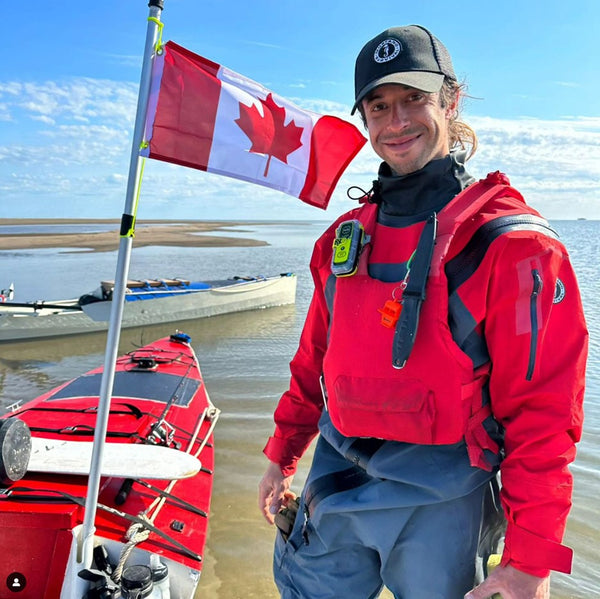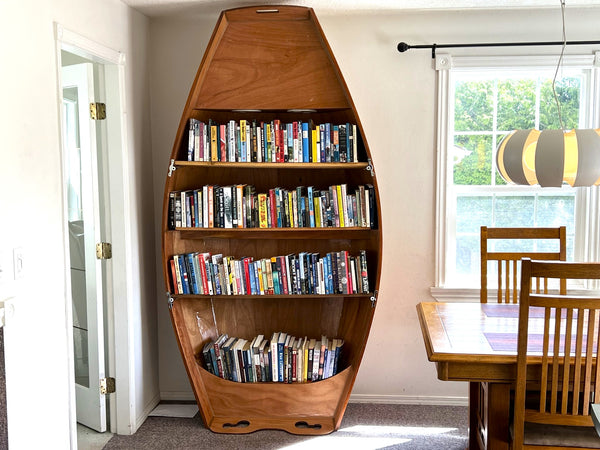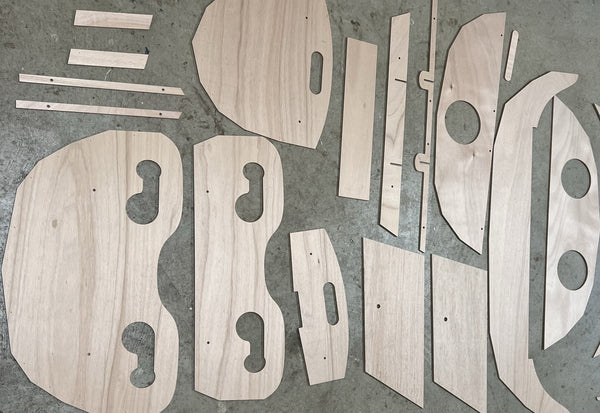Race to Alaska: Leg One in an Angus Rowboat
The first day of leg 1 for the 2022 Race to Alaska proved to be one of the most dangerous days in the history of the race. Four boats required rescues, three having capsized and another dismasted. The majority of the boats in the race didn’t even attempt to cross the treacherous Juan de Fuca Strait in these conditions. Boats that did successfully complete the crossing were the larger sailing boats. Gale force winds combined with extraordinarily powerful ebb flows created chaotic sea states with steep breaking waves up to 10’ in height. The words of the coast guard captain on location summed it up best “We’re out here all the time, and this was the worst we have ever seen.”
having capsized and another dismasted. The majority of the boats in the race didn’t even attempt to cross the treacherous Juan de Fuca Strait in these conditions. Boats that did successfully complete the crossing were the larger sailing boats. Gale force winds combined with extraordinarily powerful ebb flows created chaotic sea states with steep breaking waves up to 10’ in height. The words of the coast guard captain on location summed it up best “We’re out here all the time, and this was the worst we have ever seen.”
It was in this maelstrom that I found myself with an Expedition Rowboat. I’d planned to compete in the first leg of the 2022 R2AK, motivated by positive memories of my previous attempt in 2017. During that race, I crossed the 70 km strait in 6 hours and 21 minutes coming in third place and averaged 5.7 knots. Conditions that year were calm, giving the human powered craft an advantage.
This year, however, was different. The forecast called for gale-force winds, and the predictions were spot on.  Due to the foul conditions, the organizers decided to add an additional day to race allowing smaller craft to wait out the storm before crossing. I, however, didn’t have the luxury of time. My wife was overseas, and I needed to get home to look after our young boys. Either I would cross on the first day, or I would have to forfeit my attempt.
Due to the foul conditions, the organizers decided to add an additional day to race allowing smaller craft to wait out the storm before crossing. I, however, didn’t have the luxury of time. My wife was overseas, and I needed to get home to look after our young boys. Either I would cross on the first day, or I would have to forfeit my attempt.
I decided I would start the race, venture out into the meat of the storm and then make up my mind as to whether I would continue the remaining 60 km across the Strait. The harbor was deceivingly calm at 5:00 AM when the race began, and it was hard to believe that in a short time a Coast Guard helicopter would be plucking hypothermic racers from the frigid Strait.
the Strait. The harbor was deceivingly calm at 5:00 AM when the race began, and it was hard to believe that in a short time a Coast Guard helicopter would be plucking hypothermic racers from the frigid Strait.
With a four-knot outgoing current, the boats were flushed quickly from the harbour and towards the Strait. My route was different from most of the other boats. All the other human powered boats and small sailboats were hugging the shore, planning on making their way along the American Coastline for a distance before camping to wait out the weather prior to crossing. For those heading directly across the Strait, a direct straight line is not possible. The US Coast Guard requires that racers stay on one side or the other of a shipping lane intersection. As with my last crossing, I planned on staying on the east side of this intersection, feeling currents would be stronger (in my favour) despite a slightly longer distance. Most boats seemed to be going the other way, and it wasn’t long before I was entirely alone.
![]()
Shortly after passing Point Wilson, the smooth waters transitioned to large breaking standing waves. The wind picked up, and massive crests crashed over my rowboat. Despite the wind and waves being on my nose, I was making good progress moving at about eight knots. As the current continued to accelerate into the gale winds, the waves grew to about eight feet in size. Frequently, they would break over my small vessel, sometimes almost filling the cockpit with water. The new electric bilge pump I’d installed just days before the race whirred reassuringly, quickly expelling the water. The bilge pump was a huge added safety feature, as the breaking waves necessitated constant oar manipulation not allowing me to bail as I normally would in moderately big waves.
At last, I was at the point where I had to make my decision. Any further, and I wouldn’t have the choice of turning back as the current would be too strong. Ahead of me was another 60 km across an open wind-tossed strait. I was experiencing the full force of storm, and felt good about the boat continuing to endure the conditions, but would I? Was it humanly possible to row 60 km into a gale? Halfway across the currents would turn against me and I would be exhausted. And the winds were expected to further increase. Just as I was making up my mind, I was swept into a particularly large wave train. I powered up the wall of a 12 foot wave, hoping to crest it before it broke.
I was too late. Just as I reached the summit, the entire top of the wave collapsed, and I went over the falls. The boat free fell about five feet before landing sideways on the face of the wave. With a wall of water slamming the boat in this broached position, I was convinced it was going to capsize. I leaned the boat hard into the wave and amazingly, it bounced along the face like a skipping rock. The flat bottom of the Expedition allowed it to surf sideways.
After the monstrous wave had passed, I decided continuing on just wasn’t worth the risk. If any malfunction occurred such as a broken oarlock or plugged bilge pump things could quickly spiral out of control.
I turned the boat around, and headed back towards Port Townsend. With the waves behind me, I was now able to enjoy the best row surfing I’ve experienced in my life. The current was now running at about 4.5 knots, so I only made forward progress when carving down the face of the waves at about ten knots or so relative to the water. Between waves, despite vigorous rowing, my GPS showed my speed at zero or even going backwards. Eventually, I made it into a counter eddy where waves were subdued, and progress was much easier. From there, it was a long slow slog back to Port Townsend, and nine hours after commencing I was back where I started.
Overall, though I wasn’t able to complete the race, I was pleased to have been able to test the Expedition in such extreme conditions. These were by far the most powerful waves I’ve experienced with an Expedition, and the boat handled like a champ. I feel the vessel could have made the crossing, but I didn’t have the confidence that I had the stamina to do the same.
The other human-powered racers and smaller sailboats wisely stayed on the south side of the Strait until the weather calmed two days later and all of them safely made it across. I felt a bit soft scooting across a day before them on the Coho Ferry, but my boys were happy that someone was there to pick them up from school.
4 Responses
Edward Epifani
Good try, glad you called it. The line between adventure and disaster can be very thin.
Rick Reece
Wow! Angus, What an adventure.! That’s great proof of the reliability and safety of the Expedition. I am still waiting for the Texas Red River to have enough water to make my trip. I think I will look into an electric bilge pump. My boat is all finished and ready to go but now it’s 104-degree weather and no relief in view. SO it will probably be in October.
Jim Duff
The skipper should share the credit with the designer. Expeditions are amazing boats.
Noel McPharlin
Water is not a safe place. We weigh up risk and make decisions because we want to live another day in this remarkable world of amazing people. There’s understandably a little disappointment but the next adventure is awaiting. Grandkids yet?
You are both an inspiration to this 65yo who’s Expedition Rowboat is still in 50 pieces in South Australia. Peacefull times. Noel.
Leave a comment
Comments will be approved before showing up.
Also in News

Human Powered Achievements through the Northwest Passage
At Angus Rowboats, our passion for adventure naturally draws us to the mystique of the Northwest Passage – one of the world's most captivating and perilous waterways. Historically, this elusive passage promised a shorter shipping route, spurring early navigators to fervently chart and struggle through its icy intricacies.
The summer of 2023 saw three audacious teams, including one using our very own RowCruiser boats, aiming to be the first to traverse NW Passage solely by human power within a single season. As the season concludes, we've chronicled these attempts, and catalogued past human-powered endeavors to navigate the Northwest Passage.

Creating a Bookcase from a Boat


Colin Angus
Author